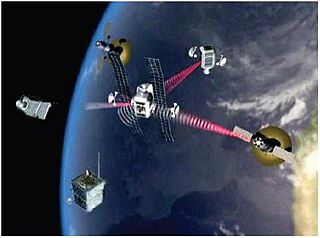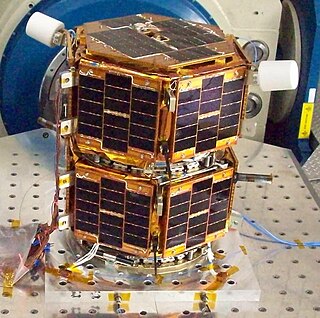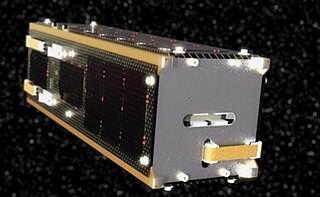
Cascade, Smallsat and Ionospheric Polar Explorer (CASSIOPE), is a Canadian Space Agency (CSA) multi-mission satellite operated by the University of Calgary. The mission development and operations from launch to February 2018 was funded through CSA and the Technology Partnerships Canada program. In February, 2018 CASSIOPE became part of the European Space Agency's Swarm constellation through the Third Party Mission Program, known as Swarm Echo, or Swarm-E. It was launched September 29, 2013, on the first flight of the SpaceX Falcon 9 v1.1 launch vehicle. CASSIOPE is the first Canadian hybrid satellite to carry a dual mission in the fields of telecommunications and scientific research. The main objectives are to gather information to better understand the science of space weather, while verifying high-speed communications concepts through the use of advanced space technologies.

A small satellite, miniaturized satellite, or smallsat is a satellite of low mass and size, usually under 1,200 kg (2,600 lb). While all such satellites can be referred to as "small", different classifications are used to categorize them based on mass. Satellites can be built small to reduce the large economic cost of launch vehicles and the costs associated with construction. Miniature satellites, especially in large numbers, may be more useful than fewer, larger ones for some purposes – for example, gathering of scientific data and radio relay. Technical challenges in the construction of small satellites may include the lack of sufficient power storage or of room for a propulsion system.
Surrey Satellite Technology Ltd, or SSTL, is a company involved in the manufacture and operation of small satellites. A spin-off company of the University of Surrey, it is presently wholly owned by Airbus Defence and Space.
The Disaster Monitoring Constellation for International Imaging (DMCii) or just Disaster Monitoring Constellation (DMC) consists of a number of remote sensing satellites constructed by Surrey Satellite Technology Ltd (SSTL) and operated for the Algerian, Nigerian, Turkish, British and Chinese governments by DMC International Imaging. The DMC provides emergency Earth imaging for disaster relief under the International Charter for Space and Major Disasters, which the DMC formally joined in November 2005. Other DMC Earth imagery is used for a variety of civil applications by a variety of governments. Spare available imaging capacity is sold under contract.

A fractionated spacecraft is a satellite architecture where the functional capabilities of a conventional monolithic spacecraft are distributed across multiple modules which interact through wireless links. Unlike other aggregations of spacecraft, such as constellations and clusters, the modules of a fractionated spacecraft are largely heterogeneous and perform distinct functions corresponding, for instance, to the various subsystem elements of a traditional satellite.
The Nanosatellite Launch System (NLS) is a series of satellite launch missions launched 2003–2010, coordinated by the Space Flight Laboratory (SFL) of the University of Toronto Institute for Aerospace Studies (UTIAS).
The Near Earth Object Surveillance Satellite (NEOSSat) is a Canadian microsatellite using a 15-cm aperture f/5.88 Maksutov telescope, with 3-axis stabilisation giving a pointing stability of ~2 arcseconds in a ~100 second exposure. It is funded by the Canadian Space Agency (CSA) and Defence Research and Development Canada (DRDC), and searches for interior-to-Earth-orbit (IEO) asteroids, at between 45 and 55 degree solar elongation and +40 to -40 degrees ecliptic latitude.

Formation Autonomy Spacecraft with Thrust, Relnav, Attitude and Crosslink is a pair of nanosatellites developed and built by students at The University of Texas at Austin. The project is part of a program sponsored by the Air Force Research Laboratory (AFRL), whose goal is to lead the development of affordable space technology. The FASTRAC mission will specifically investigate technologies that facilitate the operation of multiple satellites in formation. These enabling technologies include relative navigation, cross-link communications, attitude determination, and thrust. Due to the high cost of lifting mass into orbit, there is a strong initiative to miniaturize the overall weight of spacecraft. The utilization of formations of satellites, in place of large single satellites, reduces the risk of single point failure and allows for the use of low-cost hardware.

ALSAT-1 is the first Algerian satellite and it is part of a group of satellites collectively known as the Disaster Monitoring Constellation (DMC). The satellite was built by a group of engineers from Surrey Satellite Technology (SSTL) and Algerian Centre National des Techniques Spatiales (CNTS). It was the first DMC satellite to be launched of the five to seven that are planned. The DMC was the first satellite constellation designed for that objective. The launch took place on 28 November 2002 from the Plesetsk Cosmodrome in northern Russia on a Kosmos-3M launcher in -20 degree Celsius weather. It completed its mission after seven years and nine months in August 2010. The satellite was designed to operate for five years.
UK-DMC or UK-DMC 1, also known as BNSCSAT-1, was a British satellite that formed part of the Disaster Monitoring Constellation (DMC). It was built by Surrey Satellite Technology, who operated it via DMC International Imaging on behalf of the British National Space Centre and later the UK Space Agency. It was launched alongside other DMC satellites on 27 September 2003, and retired from service in November 2011.
Miniature Sensor Technology Integration-3 (MSTI-3) was a technology demonstration satellite operated by the United States Air Force. It was equipped with two infrared cameras and one visible light camera, designed to survey Earth's surface features and characterize their appearance in infrared wavelengths. MSTI-3 launched on 17 May 1996 aboard an Orbital Sciences Pegasus rocket.
STRaND-1 is a failed 3U CubeSat developed by Surrey University's Surrey Space Centre (SSC) and Surrey Satellite Technology (SSTL). The 4.3 kg (9.5 lb) nanosatellite was launched into orbit on board a PSLV Rocket from India on February 25, 2013, Smartphones have flown in space before inside the International Space Station, and the computer from a PDA launched inside two Japanese CubeSats in 2006 and 2008.
SLOSHSAT-FLEVO is a microsatellite launched to investigate the dynamics of fluids in microgravity. FLEVO stands for Facility for Liquid Experimentation and Verification in Orbit. Multiple sensors were used to monitor the behavior of water in an instrumented tank and how sloshing affects the attitude control of launchers and space vehicles.
SHERPA is a commercial satellite dispenser developed by Andrews Space, a subsidiary of Spaceflight Industries, and was unveiled in 2012. The maiden flight was on 3 December 2018 on a Falcon 9 Block 5 rocket, and it consisted of two separate unpropelled variants of the dispenser.

InflateSail was a 3U CubeSat launched on PSLV C38 on 23 June 2017 into a 505 km polar Sun-synchronous orbit. It carried a 1 m long inflatable rigidizable mast, and a 10 m2 drag-deorbiting sail. Its primary aim was to demonstrate the effectiveness of drag based deorbiting from low Earth orbit (LEO). Built by Surrey Space Centre of the University of Surrey, it was one of the Technology Demonstrator CubeSats for the QB50 mission. An identical drag sail payload was planned to be included on the RemoveDEBRIS demonstrator.
CubeSail is a proposed nanosatellite project by the Surrey Space Centre (SSC) in England. The spacecraft is to be a 3U CubeSat propelled by a 25 m²solar sail. The project is financed and technically supported by aerospace manufacturers Astrium and Surrey Satellite Technology.
Team Miles is a type of nanosatellite called 6U CubeSat that will demonstrate navigation in deep space using innovative plasma thrusters. It will also test a software-defined radio operating in the S-band for communications from about 4 million kilometers from Earth. Team Miles will be one of ten CubeSats to be carried with the Artemis 1 mission into a heliocentric orbit in cislunar space on the maiden flight of the Space Launch System (SLS) and the Orion spacecraft, scheduled to launch in 2022.

Orbital Express Launch Ltd., or Orbex, is a UK-based aerospace company that is developing a small commercial orbital rocket called Prime. Orbex is headquartered in Forres, Moray, in Scotland and has subsidiaries in Denmark and Germany. Its future launch complex is proposed to be built on the A' Mhòine peninsula in the county of Sutherland, northern Scotland.
HIBARI is a space mission by Japan for a microsatellite that would test a new attitude control (orientation) method to achieve high accuracy pointing for its small telescope, and was launched on 9 November 2021 by an Epsilon launch vehicle as part of the Innovative Satellite Technology Demonstration Program-2 mission. The key technology to be tested on HIBARI is called "Variable Shape Attitude Control" (VSAC), and it is based on reaction torque by rotating its four solar array paddles.

RSat-P is a microsatellite built by the United States Naval Academy (USNA) in Annapolis, Maryland. The small spacecraft is a 3U CubeSat intended to demonstrate capabilities for minor in-orbit repair of a much larger, conventional spacecraft.







